
PART - I
WITH Mercury dipping to record lows, winter 2019-20 was more atrocious than usual. The political atmosphere too was quite depressing, what with the passage of CAB even in the Rajya Sabha thanks to help from the BJP's loyal opposition and the apex court visibly reluctant to discharge its constitutional responsibility of blocking a patently unconstitutional legislation. It appeared that, setbacks in certain state-level elections notwithstanding, at the national level the BJP was destined to be successful in pushing through the diabolical CAA-NRC-NPR project by selling it as a pro-Hindu measure.
Suddenly there was a change in the situation. A dramatic change, a game-changer to boot.
Springtime in a Cruel Winter
What happened is this. With the incumbent government, the Parliament and the judiciary – and the political class generally – repeatedly failing the people on a whole host of issues, the latest being the question of citizenship, the citizens themselves now intervened directly and decisively. Led by the student community, they took the matter in their own hands.
The State of Assam, with its very special concerns on the citizenship issue, was the first to explode in protests, immediately followed by other states in the Northeast. The fact that these were BJP/NDA-ruled states did not help, neither did large-scale repression. Before the crisis could be partially managed with sops like Inner Line Permits, people in the national capital and the rest of India were up in arms. There was no Gandhi, no Bhagat Singh, no CM, no JP, not even someone like Anna Hajare to call them to action. The Youth of India rose on its own, “like lions after slumber, in unvanquishable number “, and blazed a new trail. The battered minority community, particularly their women, turned around and supplied the crucial muscle to the movement. Other sections of people saluted the vanguards and happily followed their lead. Artists, poets, singers, actors, authors, social scientists and who not – broke the suffocating silence thrust upon them and joined the agitation spontaneously and in their own creative ways, making it broader in sweep and more colourful, meaningful and impressive. They were worried and angry no doubt, but at the same time happy to have come out of their small closets – home, workplace, or whatever – and march with, mix with and shout their lungs out with a largely unknown heterogeneous crowd representing the pluralist cultural mosaic that is India. For the young and the old, for women and men, for Hindus, Muslims, Sikhs and others, it was a liberating experience: a rediscovery of India, the Idea of India. Many if not most of them were hitting the streets for the first time, and they were visibly excited. Overall, the cold was still biting but it felt like the gloomy winter was gone, yielding place to a spring festival of masses on the move, pulsating with new life and optimism.
The spontaneous countrywide mass awakening caught the political class unawares. So powerful was the impact that the ever-smart Prime Minister was now at a loss how to save the day. He foolishly tried to deny the very existence of an all India NRC project and the detention centres, making himself a laughing stock.

Azadi? What Azadi?
‘We are already a free nation, so those who always chant 'Azadi' actually demand freedom from Hindustan. They are antinational, they are traitors to the nation.’ Thus goes the standard Modi-Shah narrative on the slogan that comes first on every protester's lips. And it is this hateful narrative that the self-styled Rambhakt acted upon when he shouted “yeh lo Azadi” (here is Azadi for you) before shooting at an agitating Jamia student, with intent to kill.
Now, how do the protesters themselves conceive and interpret this word – this magic word?”
Azadi” – with its more advanced form “Bekhauf Azadi” (fearless freedom) and its various extensions like “khap se bhi Azadi, baap se bhi Azadi” (freedom from the oppressive caste panchayats as well as from patriarchal domination) – emerged as a signal tune of women’s movement in our country in course of the agitation against Nirbhaya rape and murder in Delhi. Implicit in “Azadi” was a demand for nondiscrimination and gender Justice. Now the enchanting slogan has resurfaced with larger traction and broader, more radical implications. As protesters on the ground have said on record umpteen times, they demand freedom from poverty and unemployment, corruption and neoliberalism, intolerance and vigilantism, discrimination and divisiveness, tanashahi and hatemongering, and so on.
To put it in another way, Azadi today is a dynamic, expansive idea. As it grips wider and wider sections of people, the latter enrich it with their varied demands and aspirations. What Akhtarista Ansari, one of the Jamia students (an AISA activist) who shielded her fellow student from police batons, told Caravan Magazine (2 February, 2020) gives us a fair idea of what stirs the youth of India today. As she puts it, Azadi is a freedom that includes everything from self-determination in Kashmir, to bodily autonomy for young women in public spaces, to dignity for Dalits, to freedom from racial prejudice for students from the North-East, to equality for the queer community, to self-respect and freedom from police-profiling for young Muslims, to affordable education for all students, and to fair wages for workers. Obviously, also remunerative prices and freedom from debt trap for farmers, proper facilities and a dignified life for differently-abled persons and so on – one could add on endlessly. And this comprehensive freedom can be and has to be achieved, protesters firmly believe, only by inquilab, that is revolt.

Inquilab, Mohabbat, Solidarity
One of the many eloquent graffitis out there on the walls of Shaheen Bagh depicts two women close together, one saying “inquilab zindabad” and the other – “mohabbat zindabad”. Yes, for the agitators the two slogans or notions are complementary, not contradictory. To rebel against – and to attain freedom from -- injustice, oppression and hate, you need unity and a bond of love with all compatriots, you need proactive fraternity, that is solidarity/camaraderie in struggle.
The present movement has been witness to very many ways of expressing solidarity. In all the sit-in protest sites you can see volunteers and/or street vendors distributing tea, snacks, food packets, drinking water etc. free of cost – in some cases even regular langars arranged usually by Sikh volunteers. A lady from far-off Gangotri, a sacred pilgrimage centre for devout Hindus, comes all the way to Delhi to stand with her sisters in Shaheen Bagh, takes the stage, and is warmly welcomed. A young man from Jabalpur joins the agitators in Shaheen Bagh, wearing only his shorts and covering his body with a big poster. He challenges the Prime Minister to recognise him by his clothes and asked how he withstands the cold wave in Delhi at night, replies: if all these people can spend night after night in this weather, can't I bear with it for a few hours? In many places Hindu, Muslim, Christian and Sikh religious heads have led protest marches hand-in-hand; one can cite a hundred similar instances.
In fact camaraderie is writ large on every phase, every episode in the movement. The original Shaheen Bagh was started primarily to express solidarity with the battered students of Jamia, even as hundreds of students from other colleges and universities along with concerned Delhites thronged police headquarters throughout the night, and departed only after securing the release of all the arrested students. Immediately after getting the news of the masked storm-troopers’ brutal attack on JNU, students and citizens of Delhi rushed to the site and assembled at police headquarters demanding immediate action, while students of Mumbai launched a protest at the Gateway of India that very night. Next morning the agitation spread throughout the country. Thus expression of solidarity itself becomes a form of struggle, and often invites state repression.
It is this mohabbat, this love and concern for fellow Indians cutting across class, caste, religious and other divides is a great strength of the ongoing struggle against the CAA-NRC-NPR conspiracy. It showcases a surge in people-first patriotism, which is a powerful antidote against communal hate-mongering and virulent majoritarian nationalism. The massive countrywide awakening thus helps revive a great legacy of our freedom movement, and this has the potential of going a long way in healing the wounds of partition. More on this in Part II.
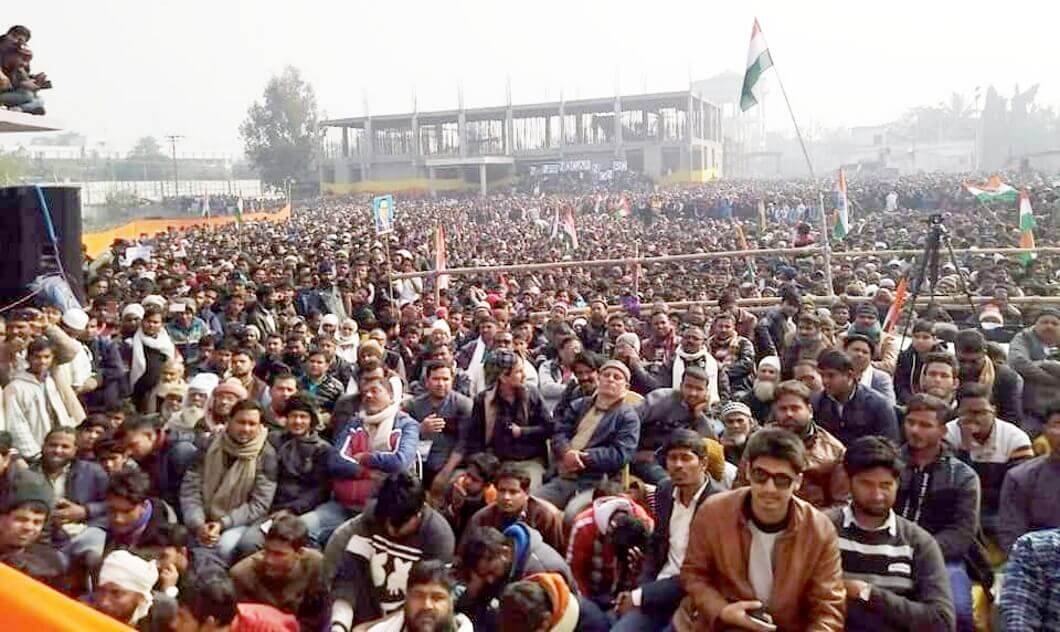
Movement against CAA-NRC-NPR: a Brief Timeline
Stage I: Agitation spreads from North-East to JMU and AMU
4 December
The moment the Citizenship (Amendment) Bill is cleared by the Union Cabinet for introduction in the Parliament, Assam and Tripura explodes in massive militant protests.In Dispur, several thousands of women and men break down police barricades to protest in front of the Assam Legislative Assembly.
8 December
AASU members ransack AGP office in Dibrugarh for suporting CAB in Parliament.
11 December
PM Debbarma, from the Tripura royal family, leads a several thousands strong rally in Agartala.

12 December
CAB becomes an Act. Demonstrations start in Noth-Eastern states. Curfews, arrests, lathi charges, internet shutdowns, even army deployment, are taken recourse to in many places.
Dipanjal Das and Sam Stafford among four killed in police firing in Guwahati. Many including Akhil Gogoi taken into preventive custody.
14-15 December
Protestor Ishwar Nayak and Abdul Alim killed in police firing at a protest in Guwahati.
15 December
Huge protest against CAA at the Jantar Mantar in New Delhi.
Police enters the premises of Jamia Milia University by force and without permission soon after violence erupted outside the campus during protests, on the pretext of nabbing the perpetrators of violence. They even break into the library and mercilessly beat up students everywhere.

Protests held outside AMU; security forces launch brutal attack inside the campus with chants of ‘Jai Shree Ram’. More than 60 students including president of students’ union grievously injured.
Sit-in protest begins at Shaheen Bagh, barely two kilometers away from Jamia campus to express solidarity with students and demanding withdrawal of CAA.The PM forced to cancel his 15-16 December meeting with Japanese Premier at Guwahati fearing massive demonstration.
Stage II: JNU and One, Two, Three, Many Shaheen Baghs

16 December
Hunger strike jointly organised by the ruling LDF and UDF in Thiruvanantapuram.
Students and teachers of IIM Ahmedabad detained by police for peaceful protest.
Students of Osmania, Hyderabad and MANU univrsites assemble in powerful protest in the capital of Telangana and by 23 December the agitation spreads to smaller towns in the state.
17 December
Violent clashes in Delhi's Seelampur area. A number of protesters and officers injured, a police station set on fire.
A dawn-to-dusk shutdown observed in Kerala.
18 December
The apex court refuses to stay implementation of CAA.
Statement condemning brutalisation of students at JMU and AMU signed by signatories from more than 1,100 academic institutions across the world, including all IITs, JNU, DU, the ISI, the Tata Institute of Fundamental Research etc. from India.
19 December
Bihar Bandh called by Left parties – marked by the participation of common people across communities Massive participation in the Ham Bharat Ke Log protest gatherings across India.
Over 700 students from Punjab university together with others from adjoining districts stage a spirited protest in Chandigarh.
Three protesters (2 in Mangalore and 1 in Lucknow) killed in police firing.
Prohibitory orders imposed on public gatherings in BJP-ruled states such as Karnataka, Uttar Pradesh and large parts of Delhi. In spirited denial, several prestigious institutes in Kozhikode including IIM protest on 19-20 December.
Tens of thousands of people protested in Hyderabad, Patna, Chandigarh, Mumbai and other cities, including ‘no protest areas’ like Bengaluru and Delhi's Red Fort. In Bengaluru, historian Ramchandra Guha along with several other professors arrested, even as the IIM organises a novel ‘shoe satyagraha’. To avoid arrest outside the campus, students and teachers display their footwear and placards outside the main gate and demonstrate inside near the gate.
In Mangaluru, two persons die in police firing. The police later forces its way into the hospital where other victims were being treated.
Thousands of protesters gather at Moulali in Kolkata and an estimated twenty thousand at the iconic August Kranti Maidan in Mumbai organised by “Hum Bharat ke Log”.

20 December
7 protesters (one each in Meerut, Sambhal, Muzaffarnagar, Kanpur and Firozabad and 2 in Bijnor) killed in separate incidents of police firing in UP.Bhim Army Chief Chandrashekhar Azad conducts a protest march at the Jama Masjid in Delhi.
21 December
Approximately 1.5 km long Protest march in Kolkata.
Bihar Bandh called by RJD.
18-year-old protester Amir Hanzla beaten to death in Patna by Hindutva extremists.
24 December
German student at IIT Madras deported by the Indian authorities for participating in the anti- CAA protests.
Video-clips of police ransacking homes, shops and cars and accusing and arresting protesters for taking part in vandalism emerge from various parts of Uttar Pradesh.
1,000-1,200 protesters booked just for organising a candle light march in AMU!.
28 December
In Meerut, U.P. government demands ₹25,000 each from more than 140 people as penalty for damages allegedly caused during protests.
LGBT Rights activists protests against the CAA and NRC at the Kolkata Pride Parade.

31 December
Protests held during New Year's Eve celebrations in Delhi, Hyderabad, Bhubaneshwar, Mumbai and Kolkata.
1 January
Five-lakh strong anti-CAA rally organised in Kochi.
4 January
One lakh protestors attend a “Million March” in Hyderabad.
Stage III: Intensified Attacks, Robust Resistance
5 January
A masked mob of armed AVBP goons attack and vandalize the campus of JNU with full complicity of the VC, the police and the Modi government. Instantaneous protests everywhere, including a huge gathering called “Occupy Gateway” in front of the Gateway of India organised that very night.
8 January

All India General Strike called by workers and unions, and a rural India strike called by peasants’ organisations – integrating the demands to scrap CAA NPR NRC with the demands to safeguard workers’ and peasants’ rights.
Thousands of people joined the anti-CAA protests at Dibrugarh, Guwahati and other parts of Assam. PM Modi, afraid to face the people, forced to cancel his visit to Assam.
11-12 January
PM Modi feels the ire of protesting Bengalis during his two-day official visit to W B right from the Kolkata airport. Several protests are organised throughout the state. The PM cannot address any rally and is compelled to move by waterways and by helicopters.
A “Tiranga Rally” against the CAA held in Hyderabad, with thousands of people displaying the national flag.Thousands of people join the anti CAA protests at Jogeshwari in Mumbai with slogans such as “I Am From Gujarat, My Documents Burned in 2002”.
14 January
The Kerala government approaches the Supreme court to challenge the CAA under Section 131 of the Constitution. Earlier the Kerala Assembly had passed a resolution against the CAA, followed by Punjab, Rajasthan and WB Assemblies.
5000 women staged a sit in protest at Mansoor Ali park (Roshan Bagh) in Allahabad, Uttar Pradesh.
In Gujarat, people celebrated Makar Sankranti by flying kites with slogans for and against CAA.
15 January
More than 200,000 people join the Anti-CAA protests in Mangalore, where hundreds of people came in boats carrying Indian flags. Harsh Mander and former IAS officer Kannan Gopinathan address the protestors.
Women’s protests come up at Patna's Sabzibagh, Kolkata's Park Circus, Kanpur's Chaman Ganj, Gaya’s Shanti Bagh.
17 January
Around 500 women starts a sit in protest at the Clock tower grounds in Lucknow. A vindictive police force tries to disperse them the very next day, but the sit-in continues despite repeated harassments.
19 January
In Berlin, Germany more than 200 people, mainly of Indian origin, join the protest march against CAA, NRC and the attack on JNU.

20 January
Massive mobilisations in the pledge-taking rallies all over India organised by Young India Against CAA NPR NRC
21 January
More than 300,000 people join an anti-CAA protest rally at Kalaburagi in Karnataka.
More than a hundred women, who had been protesting at Khureji Khas in Delhi since 14 January, released 10,000 gas filled black coloured balloons with the message “No CAA NPR NRC”.
22 January
Thousands of students from nine universities in North-East India boycott classes and join protest march in the states of Assam, Nagaland, Meghalaya and Arunachal Pradesh.
25 January
Massive Human Chain in Bihar, with people joining hands across rural and urban communities to show unity in opposing CAA NPR NRC.
In London, around 2000 people from the Indian diaspora and the Human Rights organisation, conducted a protest march against CAA from the Downing street to the Indian High Commission.
26 January – Republic Day
All across the country people in their thousands hit the street to reclaim the Republic. In Shaheen Bagh, Radhika Vemula, mother of Rohith Vemula, join the Dadi Maas in unfurling the National Flag. Nearly one lakh women and men assemble there in celebration of the 70th anniversary of the Republic Day.
More than 300 eminent personalities in India including Naseeruddin Shah, Javed Jaffrey, and Mira Nair, signed and issued an open statement against the CAA. Protests are held in Delhi, Mumbai, Hyderabad, New York, Washington DC, Chicago, London and many other cities abroad. Six to seven million people participate in a human chain extending from Kasaragod to Kaliyikkavila in Kerala.
27 -30 January
Failing to stem the rising tides of protest in newer areas with state repression, and panicked at the frightful prospect defeat at Delhi elections, the Sanghis go over to direct incitement of mob violence. Union Minister Anurag Thakur incite a captive crowd asking them to fire at ‘traitors of the nation’. Two days later, on 31st January, a self-proclaimed ‘Ram-Bhakt’, whose FB posts revealed links with the RSS, fires at the peacefully protesting students of JMU. The bullet just misses the chest and injures an unarmed protestor.
1 February
The communal bullying continues with full state support. A Hindutva fanatic fires bullets in Shaheen Bagh, chanting slogans like “Hindu Rashtra Zindabad” and “Sirf Hinduo ki chalegi” (“Only Hindus will have their way”).
2-7 February
Responding to a threat of attack on Shaheen Bagh issued by right-wing terrorist group Hindu Sena on 2 February, well-known artists and groups like Kusha Kapila, Ankur Tewari, Shuva Mudgal, Madan Gopal Singh, rock band Adaivta, Rajasthani folk troupe Kutle Khan, new wave band Mumphali and others take up the gauntlet and hurriedly organise a cultural fest at the protest site, from that very day, under the bannere ‘Artists against Communalism’. The Hindu Sena calls off the programme.
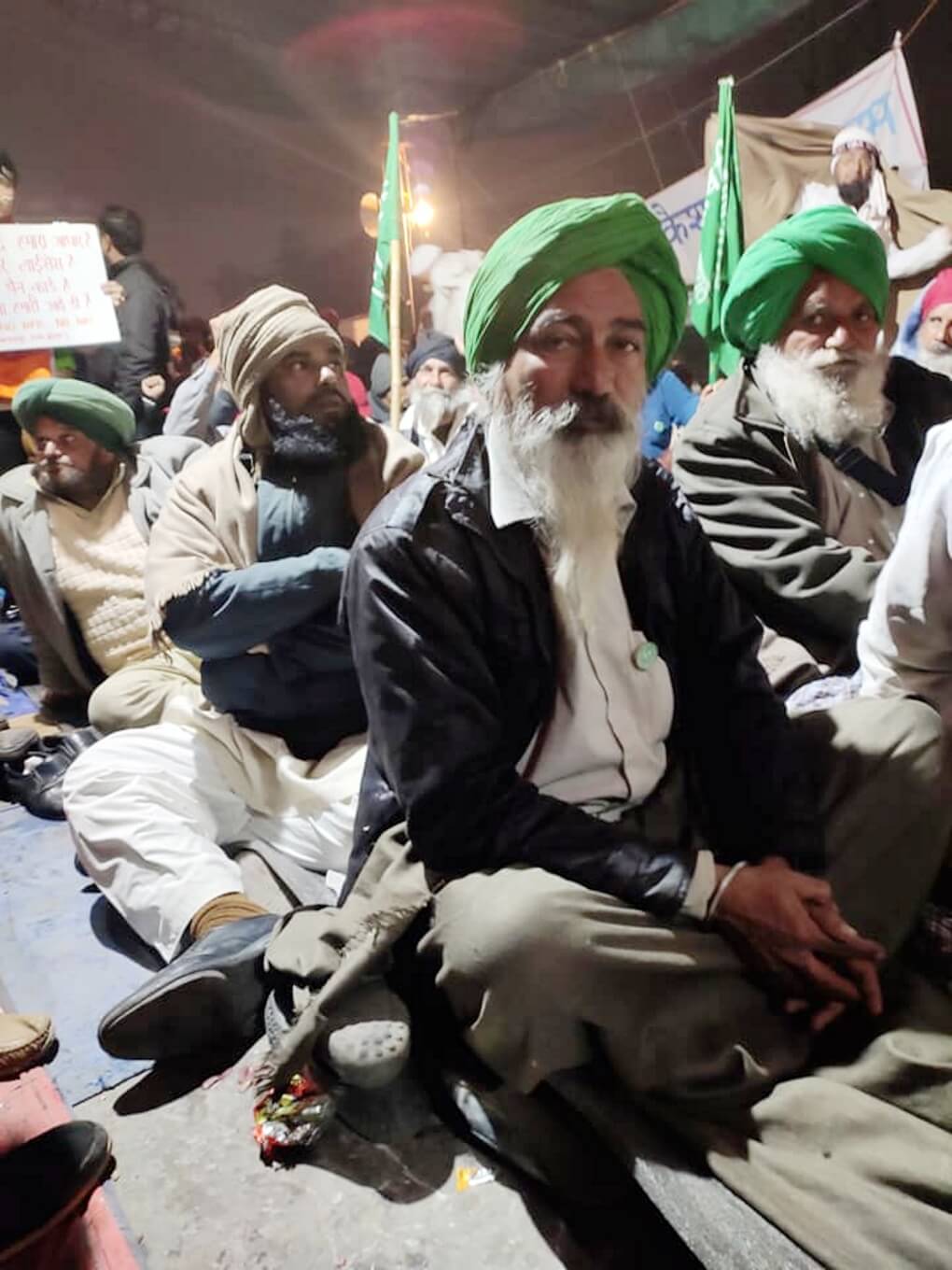
On 3 February, a massive contingent of Sikh farmers from Mansa, Punjab, under the banner of the Punjab Kisan Union, march into Shaheen Bagh. They stay till 5 February, offering solidarity and protection. Many cook food for everyone at Shaheen Bagh. This gesture sends a powerful message of unity and solidarity in the face of the terrorist threats to Shaheen Bagh.
14 February
A sit-in begins at Vannarapettai (Washermanpet) – renamed as Shaheenpet – in Chennai following a brutal lathi-charge by the police on peaceful protestors. On 17th February a previously engaged couple ties the knot at the protest site with a copy of the constitution in hand.
16 February
Sushant Singh, Nandita Das, Teesta Setalvad and others join in yet another mammoth rally in Azad Maidan, Mumbai. Recital of ‘Hum Dekhenge’ and slogans like ‘Modi se, Shah se azadi’ rend the air.
19 February
Thousands march to the Secretariat in Chennai in defiance of a High Court Ordering permission for the same. Main demand: the TN Assembly must pass resolution against the CAA.
Supreme Court-appointed mediators Sanjay Hegde and Sadhana Ramachandra visit Shaheen Bagh and start a dialogue with protestors in an effort to try and find an alternative site for protest through consultations. The women of Shaheen Bagh ask, ‘If the Government hasn’t reached out to us when we are here, will they do so if we move?’
[Note: The timeline is only indicative, not exhaustive. Protests in various forms took place in many other places too, such as Shillong, Margao, Imphal, Dehradun, Haridwar, Nainital, Haldwani, Jabalpur etc. The timeline does not cover the numerous initiatives taken by our party, the more important ones being already reported in party publications.]
Liberation Archive
- 2001-2010
-
2011-2020
- 2011
- 2012
- 2013
- 2014
- 2015
- 2016
- 2017
- 2018
- 2019
-
2020
- Liberation, JANUARY 2020
- Liberation, FEBRUARY 2020
-
Liberation, MARCH 2020
- Delhi 2020 Verdict – A Much Needed Blow to the Modi-Shah Regime
- Modi and Trump: Two Tyrants Meet in an Extravaganza Wasting Crores! But Does It Benefit India and Indians?
- SC Verdict on Reservation in Promotions
- Population Control Is Anti Women, It Is Not Reproductive Justice
- The Countrywide Upsurge against CAA-NRC-NPR: What We Have Achieved and What Comes Next
- Kanpur's women-led NRC protest has overturned local power structures: ‘They aren't listening to us’
- Campaign Diary: Comrade Kavita Krishnan in Bihar
- Against Fascism – Women Shall Fight And Win! 8th National Conference of AIPWA Held at Udaipur
- Rise In Rage Against Sexual Assault By A Mob Against Students At Gargi College And By Delhi Police Against Jamia Millia Islamia Students
- CPIML condemns slapping of NSA on Dr Kafeel
- Release Chauri Chaura Padyatris without Delay
- Sanitation Workers’ Struggle in Bihar Against Outsourcing
- Preparations on for Vidhan Sabha March on 25 February
- Left Parties Report on Police Brutality in Bilriyaganj (Azamgarh)
- False Cases slapped on Party Leaders in Pilibhit
- Fearless Freedom
- Liberation, APRIL 2020
- Liberation, MAY-JUNE 2020
- Liberation, JULY 2020
- Liberation, AUGUST 2020
- Liberation, SEPTEMBER 2020
- Liberation, OCTOBER 2020
- Liberation, NOVEMBER 2020
- Liberation, DECEMBER 2020
- 2021-2030
Charu Bhawan, U-90, Shakarpur, Delhi 110092
Phone: +91-11-42785864 | Fax:+91-11-42785864 | +91 9717274961
E-mail: info@cpiml.org







